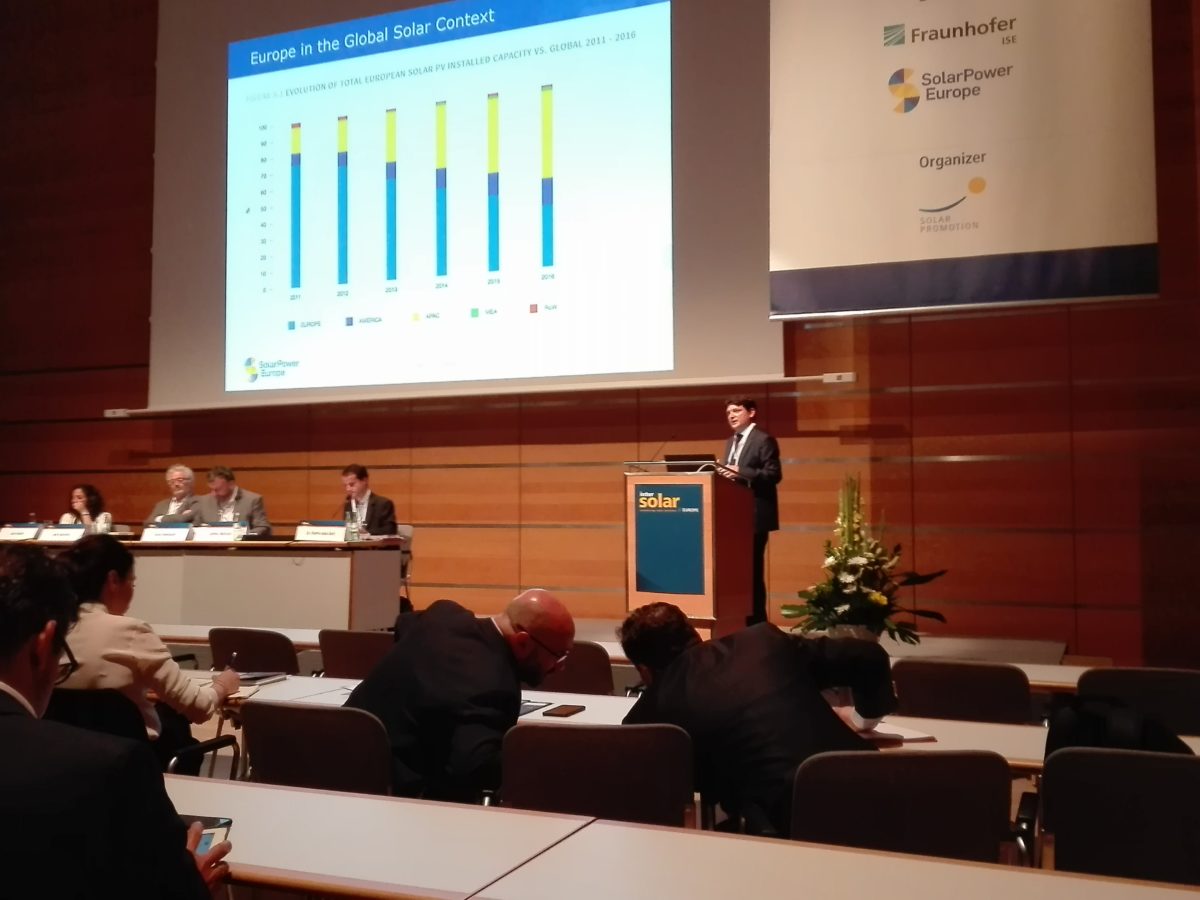Global solar installations will not match the rate of growth seen in 2016 but should still surpass 80 GW this year, said SolarPower Europe CEO James Watson on day one of the Intersolar Europe conference in Munich, Germany.
Global growth of more than 50% pushed 2016’s annual installation total to 76.6 GW, with this year on course to surpass that record figure, Watson said.
“Despite the gigantic leap that resulted in the more-than 50% growth year-on-year of annual solar installations in 2016, there is a good chance that the market could even pass the 80 GW mark in 2017,” Watson remarked.
SolarPower Europe president Christian Westermeier added that for the first time ever, solar has “left behind” its renewable energy peer, wind, in terms of annual installations. “This proves the versatility and increasing cost-effectiveness of solar power.”
Much of this growth has been driven by quickly decreasing solar costs that are making the technology even more competitive than ever with fossil fuels and nuclear energy. In fact, all solar tenders awarded since 2016 are lower than the price guarantee struck by the U.K. for its controversial Hinkley Point C nuclear plant, SolarPower Europe said.
A record-low price of just 2.4 U.S. cents/kWh struck in Abu Dhabi in 2016 has prompted the Brussels-based solar body to produce a more “optimistic” report than in previous years, SolarPower Europe executive advisor Michael Schmela said.
“If policy makers get things right by addressing the needs for a smooth energy transition, such as through establishing the right trade policy, electricity market design and renewable energy frameworks, solar demand could increase much faster, and touch nearly 1 TW of total generation capacity in 2021,” Schmela added.
Europe: strong, stable, but lacking dynamism
In a later session, SolarPower Europe CEO Watson returned to the stage to talk specifically about Europe’s solar outlook. What was once the undisputed leader and innovator in the solar industry is in danger of being left behind, Watson warned, although he added that “strong and stable” need not signal a death knell for European growth.
“We can lament the loss of the huge leadership of Europe in 2011, but now solar is a truly global phenomenon,” said Watson.
Popular content
“Europe ended 2016 with 104,297 GW of cumulative capacity, but the continent has rapidly been pushed into second place by the APAC region. “Growth is tapering off since the great peaks of 2011 and 2012,” Watson added, stressing that the current growth trajectory is “now in a flatlining position”.
The CEO said that Europe added just 6.7 GW in 2016 – a 21% decrease on 2015. However, despite the expected decline of the U.K. market in 2017, there is hope that markets such as Turkey and the Netherlands can more than make up for this expected shortfall and even push cumulative installations in 2017 to 8 GW in Europe.
“Solar currently meets just 4% of Europe’s electricity demand,” said Watson. “Wind is at 12-13%, gas and coal are both higher, and nuclear is at 27-28%, so solar has a long way to go to become a core element of the European electricity system.”
The amount of new power generation capacity going into the grid is actually low across all sectors in Europe because the continent is generally oversupplied. “Europe is too slow to retire coal and nuclear plants, which simply means that solar doesn’t have the space in which to grow,” said Watson, adding: “This is ironic given its achievements – average solar prices dropped by 24% between 2015-2016, and by February 2017 that decline had grown to 28%, so there has been a continual decrease in costs for solar. We should be seeing much more solar than we really are.”
A theoretical LCOE for solar in southern parts of Europe could be close to three U.S. cents/kWh, according to SolarPower Europe calculations, but to reach these competitive prices European policymakers have to become more positive and proactive, concluded Watson.
“We need a trade policy that supports the growth of solar in Europe. Nobody is really happy with current policy, it cannot be good for the continued decrease in the LCOE we need in order to have competition with other technologies. Measures such as trade barriers need to be removed. The European Commission (EC) proposal of 27% of renewable energy by 2030 is nothing more than business as usual.
“We need a target of 35%, this is the only thing that is viable in our opinion. We also need a proper framework that puts prosumers at the heart of the energy system; the right to self-generate and self-consume needs to be embraced by all governments in Europe.”
This content is protected by copyright and may not be reused. If you want to cooperate with us and would like to reuse some of our content, please contact: editors@pv-magazine.com.


1 comment
By submitting this form you agree to pv magazine using your data for the purposes of publishing your comment.
Your personal data will only be disclosed or otherwise transmitted to third parties for the purposes of spam filtering or if this is necessary for technical maintenance of the website. Any other transfer to third parties will not take place unless this is justified on the basis of applicable data protection regulations or if pv magazine is legally obliged to do so.
You may revoke this consent at any time with effect for the future, in which case your personal data will be deleted immediately. Otherwise, your data will be deleted if pv magazine has processed your request or the purpose of data storage is fulfilled.
Further information on data privacy can be found in our Data Protection Policy.